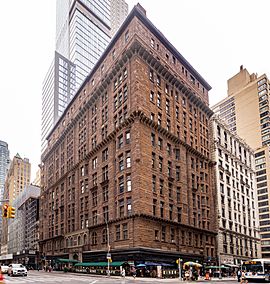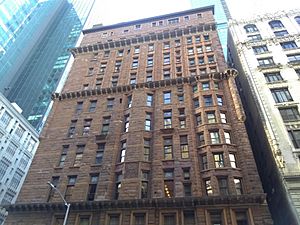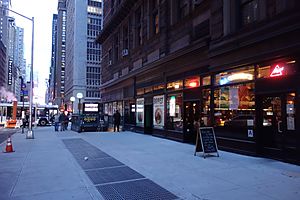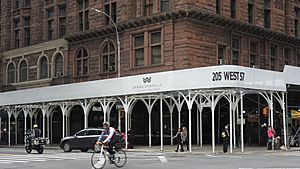The Osborne facts for kids
Quick facts for kids The Osborne |
|
|---|---|

Southeast corner as seen in 2021
|
|
| General information | |
| Type | Housing cooperative |
| Architectural style | Italian Renaissance |
| Address | 205 West 57th Street |
| Town or city | New York City |
| Country | United States |
| Coordinates | 40°45′57″N 73°58′49″W / 40.76583°N 73.98028°W |
| Construction started | 1883 |
| Completed | 1885 |
| Renovated | 1891, 1906, 1962 |
| Technical details | |
| Structural system | Masonry bearing wall; steel-framed annex |
| Floor count | 11 (front) 15 (rear) |
| Design and construction | |
| Architect | James Edward Ware |
| Main contractor | Thomas Osborne |
|
Osborne Apartments
|
|
| Location | 205 West 57th Street, Manhattan, New York |
| Built | 1883 |
| Architect | James E. Ware |
| Architectural style | Renaissance, Romanesque |
| NRHP reference No. | 93000333 |
| Significant dates | |
| Added to NRHP | April 22, 1993 |
The Osborne is a famous apartment building in Midtown Manhattan, New York City. It is located at Seventh Avenue and 57th Street. This building is also known as the Osborne Apartments or 205 West 57th Street.
It was designed by James Edward Ware and built between 1883 and 1885. Later, in 1906, an extra section was added to the west. This part was designed by Alfred S. G. Taylor and Julian Clarence Levi. The Osborne is one of the oldest and most luxurious apartment buildings in New York City.
The outside of the Osborne is covered with rough-cut brownstone blocks. It has a main entrance on 57th Street and many different window styles. The first floor has a fancy entrance area and lobby. The other floors have apartments that are often split into two levels (duplexes).
The front part of the building, facing 57th Street, is 11 stories tall. It originally had large living areas with high ceilings. The back part of the building is 15 stories tall. This section had bedrooms and rooms for servants. The Osborne first had 38 apartments. However, many of these were divided into smaller units starting in the 1920s.
The building is named after Thomas Osborne, who was a stone contractor. He bought the land in 1883 and built the Osborne as an investment. The building cost $2 million to build, which was a lot of money back then. This high cost caused Thomas Osborne to lose the building. The family of John Taylor, who originally sold the land, bought the building in 1889.
The Taylor family sold the Osborne in 1961. The next year, it became a housing cooperative. This means the residents own shares in the building. Many artists, actors, and musicians have lived here. It has also been home to doctors and lawyers. The New York City Landmarks Preservation Commission made the building a city landmark in 1991. It was added to the National Register of Historic Places in 1993.
Where is the Osborne Building?
The Osborne building is located on the northwest corner of 57th Street and Seventh Avenue. This is in the Midtown Manhattan area of New York City. It is just two blocks south of Central Park.
When it was first built, the Osborne was 150 feet (46 m) long on 57th Street. It was 100 feet (30 m) long on Seventh Avenue. In 1906, the building was made 25 feet (7.6 m) longer to the west. This made it 175 feet (53 m) long on 57th Street. The total area of the land is about 17,572 square feet (1,632.5 m2).
The Osborne is close to other important buildings. These include the American Fine Arts Society and the Central Park Tower. It is also near Carnegie Hall. Right outside the building, you can find an entrance to the New York City Subway's 57th Street–Seventh Avenue station.
This area around West 57th Street became a center for artists in the late 1800s and early 1900s. This happened after Carnegie Hall opened in 1891. The Osborne was built even before Carnegie Hall. Many buildings in this area were made for artists and musicians to live in. The Osborne was also part of a group of fancy buildings built on Seventh Avenue around Carnegie Hall.
What Does the Osborne Look Like?
The Osborne was designed by James Edward Ware and built from 1883 to 1885. It was later expanded in 1906 by Alfred S. G. Taylor and Julien Clarence Levi. Ware designed the Osborne to look like an Italian Renaissance-style palace. It also has some Romanesque Revival features. These include round-arched doorways and windows, rough stone walls, and windows set back into the building.
The Osborne is the second-oldest luxury apartment building in New York City. The oldest is the Dakota, which was finished in 1884.
The main part of the Osborne faces 57th Street and has 11 stories. The back part, facing north, has 15 levels of apartments. However, the roof is at the same height as the rest of the building. The northern part of the building has two "light wells." These are open spaces that let light into the apartments.
The Osborne, including its added section, is 162 feet (49 m) tall.
Building's Outer Walls
The outside of the Osborne is mostly covered with rough-cut blocks of brownstone. Some people think this material was used to remind people of the brownstone houses common in the city. Others believe it was meant to show the strength of stone. Thomas Osborne, the developer, hoped the brownstone would attract people who lived in middle-class brownstone homes. The main structure is built with strong bearing walls up to 4 feet (1.2 m) thick.
The front of the building faces 57th Street. The side faces Seventh Avenue. The 57th Street side has ten vertical sections, called bays. The Seventh Avenue side has eight bays. Large decorative ledges, called cornices, run above the second, sixth, and ninth floors.
The outside walls have carved stone panels with classic designs. There are also oriel windows that stick out from the building. These windows let more light into the apartments. The outside of the building was made to match the fancy design of the inside.
The Base of the Building
The bottom two stories make up the base of the building. The main entrance is in the middle of the 57th Street side. It is a white, rounded arch with a decorative stone at the top. Inside the arch is a wooden double door with a glass window above it. Two pairs of columns stand next to the arch. There are also two lamps on the inner columns. The rest of the ground floor has shops.
On the second story along 57th Street, there are eight sections. The middle sections have round-arched windows. The other sections have rectangular windows. On Seventh Avenue, most sections have rectangular windows on the second story. A decorative ledge runs above the second story.
The two sections on the far west of 57th Street are part of the 1906 addition. They have three shorter stories within the height of the first two floors. These include the ground floor and two mezzanine floors. Each mezzanine has a metal window that sticks out.
Upper Floors
From the 3rd to the 6th stories, the original part of the 57th Street side has stone windows that stick out. Other sections have rectangular windows. Between the windows on the 3rd and 4th stories, there are carved stone panels. There are also stained-glass panels near the top of the windows. Decorative towers rise from the 5th and 6th stories at each corner. A similar window design is on the Seventh Avenue side.
From the 7th to the 9th stories, the 57th Street side has groups of three or two windows per story. These windows are separated by carved stone panels. Stained-glass panels are also near the top of the 7th and 8th-story windows. The Seventh Avenue side has a similar design, but each section has only one window.
On both 57th Street and Seventh Avenue, the 10th and 11th stories have rectangular windows. A horizontal band separates these floors. A copper ledge is above the 11th story.
The added section on 57th Street only goes up to the 10th story. Its design from the 3rd to 9th stories is similar to the original building. It has a metal window that sticks out and a regular window. The 10th story of the added section has three rectangular windows.
Inside the Osborne
Entrance and Lobby
The entrance area and lobby are connected. Famous artists like Stanford White, John La Farge, and Jacob Adolphus Holzer designed the decorations. The lobby has marble, mosaics, murals, gold surfaces, and leaded glass. The Tiffany glass here, made by Louis Comfort Tiffany, was one of his first big decorating jobs.
The entrance area is about 20 feet (6.1 m) square with a 20 feet (6.1 m) high ceiling. A short set of marble and copper steps leads to the main lobby.
The lobby is about 92 by 14 feet (28.0 by 4.3 m) with a 15 feet (4.6 m) high ceiling. The floors have mosaics made of small tiles and Italian marble. The walls have marble panels and plaster decorations that look like bronze. There are also carvings, mosaic tiles, and round designs on the walls. Marble seating areas have Tiffany mosaics and stained glass. The Osborne was the first building to use foil-backed mosaics in a non-religious place.
The ceiling is made of square panels and is painted in red, blue, and gold. This looks similar to the ceiling at J. P. Morgan's library. Four copper chandeliers and sixteen bronze wall lamps light the space. Two marble staircases lead from the lobby.
The Apartments
Each floor from the 2nd to the 10th story originally had four apartments. There were also two apartments on the ground floor. This made a total of 38 units. The 11th floor was used by service workers and for storage. Each upper floor was divided into a west and east side, with two apartments on each side. Each side had its own elevator and staircase. The building had four elevators and its own heating and power system.
The original apartments were designed in a special way. The main living rooms, where guests were entertained, had 15-foot (4.6 m) high ceilings. The front part, facing 57th Street, had the apartments' libraries and living rooms. The entrance, dining room, kitchen, and one bedroom also had high ceilings. The back parts had bedrooms and private bathrooms. These were separated from the main living areas by seven steps. Their ceilings were just over 8 feet (2.4 m) high.
The apartments on the far west side, added in 1906, were generally larger. They had seven bedrooms and bigger reception and dining rooms. The apartments also had fancy inside features. These included mahogany wood, bronze fireplace mantels, and crystal chandeliers. The parquet wood floors had decorative edges.
In the early and mid-1900s, many apartments were divided into smaller ones. The ground-floor apartments were removed. New apartments were created on the 11th floor. In 1993, it was noted that the Osborne had 109 units. Only 14 of these still had their original large size.
Because of these changes, the apartments today have more complex layouts. For example, an apartment might have its entrance on a back mezzanine level. Its main rooms might be in the high-ceiling part. Some units were even "apartments within apartments." This meant you could only get to them through another tenant's home. These changes sometimes led to rooms or staircases being sealed off.
History of the Osborne
In the early 1800s, apartment buildings were mostly for working-class people. But by the 1870s, apartments became popular for middle and upper-class families too. Between 1880 and 1885, more than ninety apartment buildings were built in New York City.
The invention of the passenger elevator allowed taller apartment buildings to be built. Buildings like the Osborne and the Dakota could now be taller than six or seven stories. At the same time, West 57th Street was developing with fancy townhouses. Some of these were known as New York City's best homes. The area around the Osborne was not very developed in the early 1880s. But it was close to Central Park, which was a big plus.
How the Osborne Was Built
The Osborne is named after Thomas Osborne. He was an Irish immigrant who had a very successful stone business. In 1883, he bought the land for $210,000 from John Taylor, who owned a restaurant. After a design competition, Osborne chose Ware to design the apartment building.
Ware submitted plans for an 11- and 15-story brownstone apartment building. It was expected to cost $650,000. The plans included a fireproof building with four elevators and modern heating and plumbing systems. The original plans also mentioned a rooftop croquet lawn (which was not built). There was also a private billiards room, a florist's shop, a doctor's office, and a chemist in the basement. Osborne proudly said the building would likely be the tallest in the city, at 200 feet (61 m).
In October 1883, three investors planned to buy Osborne's building for $700,000. But the sale never happened. By the next year, Osborne still hoped to sell the building once it was finished. The roof was completed by June 1884. Advertisements in newspapers called it "the most magnificently finished and decorated apartment house in the world." The first tenants moved in by November 1885. The building was later sold to John H. Taylor, John Taylor's son, for $1,209,000. The building of the Osborne encouraged other apartment houses to be built nearby.
Changes Over Time
The building ended up costing $2 million to build. The fancy decorations added a lot to the cost. This was too much for Thomas Osborne. John Taylor's family took over the Osborne in 1888. William Taylor, another family member, bought the building for $1,009,250 in March 1896. At that time, the area was growing fast.
Around 1900, a glass and metal canopy was added over the sidewalk. The Taylor family started building the 57th Street addition in 1906. This new section was designed by Alfred S. G. Taylor and J. C. Levi. It was finished in 1908. This addition gave the westernmost apartments more bedrooms.
Many businesses moved to the area in the late 1800s and early 1900s. So, in 1919, the Taylor family changed the ground-floor apartments into shops. They thought this would make more money. At this time, the original entrance porch and the moat around the ground floor were removed. The upper floors were divided into smaller units starting in 1922. The 11th-floor attic was also turned into apartments in 1941.
Becoming a Cooperative Building
By the mid-1900s, the Taylor family could not keep up with the Osborne's maintenance. The inside of the building had become run down by the 1950s. In 1961, the Osborne was sold to the Linland Corporation for $2.5 million. The owner, Sarah Korein, planned to tear down the Osborne and build a new 17-story building.
In response, the tenants gathered $500,000 to buy the building from Korein. This payment was about twice the deposit Korein had paid. The plan for the new tower was canceled. The Osborne Tenants Corporation bought the building and turned it into a cooperative in 1962.
Davida Tenenbaum Deutsch, who lived in the building and studied architecture, started holding sales in 1976. These sales helped raise nearly $100,000 to restore the lobby. By the mid-1980s, apartments in the Osborne were as expensive as those in the very wealthy Upper East Side.
From 1989 to 1994, the Osborne's cooperative board restored the outside of the building. This cost $4.1 million. During this time, Rambusch Studios restored the lobby. By the early 2000s, the Osborne became part of "Billionaires' Row." This area has many tall residential buildings for very rich people.
Famous People Who Lived Here
Even though the Osborne is close to Carnegie Hall and the arts center on West 57th Street, not many musicians, artists, or writers lived there before World War II. Only two architects were recorded as living there during that time. However, it was popular among the upper middle class. Many executives, business owners, lawyers, and doctors lived there. The building's artistic residents mostly moved in after World War II. By the 1960s, the Osborne was known as "the residential Carnegie Hall."
Some famous people who have lived at the Osborne include:
- Dana Andrews, actor
- Peter Beard, artist and photographer
- Leonard Bernstein, composer and conductor
- Shirley Booth, actress
- Jessica Chastain, actress
- Dane Clark, actor
- John Clark, actor, and his wife Lynn Redgrave, an actress
- Van Cliburn, pianist
- Gray Foy, artist, and his spouse Leo Lerman, a writer and editor
- Gary Graffman, classical pianist
- Paul Hartman, Broadway performer
- Phil Jackson, professional basketball player, coach, and executive
- Fran Lebowitz, author and public speaker
- Julian Clarence Levi, architect and art collector
- Ira Levin, novelist
- Elinor Lipman, novelist
- Sylvia Miles, actress
- Alice Nielsen, Broadway performer and opera singer
- Robert Osborne, host of Turner Classic Movies
- Charles Osgood, newscaster
- Tom Poston, actor
- Joseph M. Proskauer, judge
- Lynn Redgrave, actress
- John Coit Spooner, U.S. senator
- Bobby Short, singer
- Faith Stewart-Gordon, owner of the nearby Russian Tea Room restaurant
- Larry Storch, actor
- Blanche Thebom, opera singer and director
- Helen Traubel, opera singer
- André Watts, pianist
- Maury Yeston, composer
- Gig Young, actor
Images for kids
See Also
 In Spanish: Osborne Apartments para niños
In Spanish: Osborne Apartments para niños












